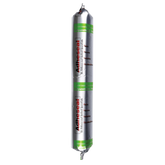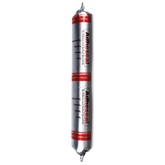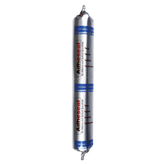
Sunstate Dried Silica Sand: A Technical Overview
Engineered at Coonarr, QLD, this white, low-impurity silica sand is wet-processed, rotary-dried and precision screened for reliable, repeatable grading. The high silica content and clean particle morphology make it a dependable mineral filler for epoxy flooring, textured wall coatings, grouts/adhesives, foundry casting and water filtration. Available grading includes F8, F6 (foundry grade) and F4, packaged dry in 20 kg bags for trade convenience.
Core Features & Specifications
- High purity silica: SiO₂ > 99% with very low Al₂O₃ and Fe₂O₃ traces for clean colour and system compatibility.
- Tightly controlled grading: typical export band with ≥95% passing 0.425 mm and ≥95% retained on 0.105 mm for predictable performance.
- Fully dried via rotary drier for low moisture and consistent dosing into resin or cement systems.
- Multiple functional grades: F8 (coatings/fillers), F6 (foundry/epoxy flooring), F4 (fine fillers, non-slip paints, grouts, acoustic infill).
- Bulk density approx. 1500 kg/m³; non-flammable, odourless, inert mineral aggregate.
- Available in trade-ready 20 kg bags for clean handling and batching.
The Sunstate Dried Silica Sand Advantage
- Consistency you can trust — controlled particle size gives even texture, slip resistance and pack density, reducing rework.
- Clean chemistry — low iron and alumina helps maintain colour integrity in light-coloured coatings and mortars.
- Versatile on site — one mineral platform covers coatings, flooring, grouts and filtration to simplify procurement.
- Dry, ready to dose — minimises clumping and moisture-related defects when mixing into epoxies or cement.
Frequently Asked Questions
Can I use this sand as an anti-slip broadcast for epoxy flooring?
Yes. Use the appropriate grading (often F6 or F8) for the slip rating you’re targeting. Broadcast onto wet epoxy, back-roll if required, then seal/overcoat after cure per your system. Ensure the substrate and product are dry to avoid blushing and poor embedment.
Is this suitable for water filtration beds?
Yes. The clean, low-contaminant silica and controlled grading make it suitable as a filter medium where the specified size distribution is met. Confirm design requirements for effective size and uniformity coefficient before selection.
Applications & Benefits
| Application / Use Case | Key Benefit | Primary Trades |
|---|---|---|
| Textured wall coatings / non-slip paints | Controlled profile and slip resistance; clean colour | Painters, Flooring Contractors |
| Epoxy flooring broadcast / build coats | Improved wear layer, traction and film build | Flooring Contractors |
| Grouts & adhesives (cementitious) | Rheology control and strength contribution | Tilers, Builders |
| Foundry casting (F6) | Clean, consistent foundry sand with tight grading | Foundry |
| Water filtration media | Low impurity, stable mineral with defined size | Water Treatment |
| Acoustic infill / sound proofing | Dense mineral fill to dampen vibration | Builders, Services Contractors |
Applying Sunstate Dried Silica Sand (GS-BW): Enhanced Protocols & Best Practices
-
Material Handling
Keep bags sealed and dry. Handle gently to minimise dust. Use local extraction or wet methods where practical.
Dry Broadcast
Distribute evenly into wet coating; allow to gel/cure, then de-dust and overcoat as per the resin system.
Premix Filler
Introduce slowly into resin or grout while mixing to avoid clumping. Verify target viscosity and flow before placement.
Timing: Broadcast during the specified open time; overcoat only once fully cured and dust-free.Pro Tip: Sieve reclaimed broadcast to remove fines before re-use; fines can dull texture and affect slip ratings.
Limitations & Safety
Product Limitations
Safety & Handling Requirements
Personal Protective Equipment
Wear dust-proof goggles, PVC/rubber/cotton gloves and coveralls when heavy contamination is likely. Use a Class P1 or Class P2 particulate respirator where an inhalation risk exists.
Ventilation Requirements
Use in well-ventilated areas. Employ mechanical extraction or wet methods to keep respirable dust below the exposure standard (TWA 0.05 mg/m³ for quartz respirable dust).
Fire & Handling Precautions
Non-flammable mineral; avoid creating dust clouds. Store cool, dry, and away from incompatible substances (e.g. strong acids such as hydrofluoric acid).
Emergency First Aid
Seek medical attention immediately in all cases of serious exposure.
Sunstate Sands F6 & F8 Application Guide
F6 – Foundry & Epoxy Flooring Applications
For foundry moulding, ensure all patterns and mould boxes are clean, dry, and free from oil or residual release agents. For epoxy floor systems, concrete surfaces must be sound and cured (28 days minimum), with laitance and contaminants mechanically removed. Vacuum clean immediately prior to resin priming or broadcast.
Apply Adheseal Epoxy Primer System to prepared concrete, then broadcast F6 sand evenly onto wet primer or base coat to create a mechanical key. No primer is needed in metal or sand mould foundry work where F6 acts as the primary mould aggregate.
Adheseal Epoxy Primer SystemF8 – Textured Coatings, Grouts & Adhesives
Ensure all substrates are clean, dry, and free of oil, dust or efflorescence. On cementitious surfaces, remove loose particles by light grinding or brushing. Verify moisture content is below 75 % RH before mixing into epoxy or cementitious systems.
Use Adheseal Primer 2001 on low-porosity concrete and masonry before applying grouts or adhesives containing F8. For architectural texture coatings, primer may not be required if sand is pre-blended into a compatible binder system.
Adheseal Primer 2001Custom Blends & Special Applications
When using custom mixes of F6 and F8, store in sealed dry conditions to avoid moisture absorption. Blend mechanically using a low-speed mixer to ensure even particle distribution before adding binders or resins.
Confirm compatibility with the manufacturer’s binder or resin before final application. For high-adhesion systems, pair with Adheseal Primer 50A for superior wetting and bond stability.
Adheseal Primer 50A- Choosing a selection results in a full page refresh.







